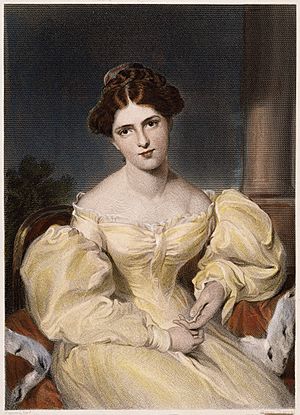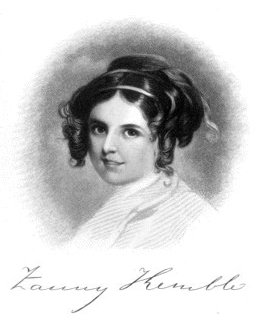Fanny Kemble facts for kids
Quick facts for kids
Fanny Kemble
|
|
|---|---|

Engraving of Fanny Kemble from before 1830
|
|
| Born |
Frances Anne Kemble
November 27, 1809 |
| Died | January 15, 1893 (aged 83) London
|
| Occupation | Actress, abolitionist and poet |
| Years active | 1827 - c. 1882 |
Frances Anne "Fanny" Kemble (27 November 1809–15 January 1893) was a British actress. She came from a famous theatre family in the 1800s. Fanny was also a well-known writer and an abolitionist, meaning she worked to end slavery.
Her published works included plays, poems, travel stories, and many books about her life. Fanny Kemble is especially important for a private journal she wrote. In this journal, she described the difficult lives of slaves on her husband's plantations. This journal helped show her strong feelings against slavery.
Contents
Early Life and Education
Fanny Kemble was part of the famous Kemble acting family. She was the oldest daughter of actor Charles Kemble and his wife, Marie Therese De Camp. Her aunt was the famous actress Sarah Siddons. Her uncle was the well-known actor John Philip Kemble. Her younger sister, Adelaide Kemble, became an opera singer.
Fanny was born in London, England. She went to boarding school in Paris, France, starting in 1821. There, she studied art and music. She also performed staged readings for parents, which was her first real experience on stage. As a teenager, Fanny loved to study literature and poetry, especially the works of Lord Byron.
One of her teachers was Frances Rowden. She was a poet and loved the theatre. People said she was very good at inspiring her students to become poets too.
In 1827, Fanny wrote her first play, called Francis the First. It was a five-act play and was praised by many critics. They said it had "spirit and originality" and showed real talent for writing plays.
Becoming a Star Actress
On 26 October 1829, when she was 19, Fanny Kemble first appeared on stage. She played Juliet in Romeo and Juliet at the Covent Garden Theatre. She had only practiced for three weeks!
Her charming personality quickly made her a favorite with audiences. Her popularity helped her father, who was a theatre manager, earn back money he had lost. She played many important women's roles. These included Portia and Beatrice in Shakespeare's plays, and Lady Teazle in The School for Scandal.
Fanny didn't really like being a famous star. But she appreciated the money she earned. This money helped her family, who often had money problems.
In 1832, Fanny traveled to the United States with her father for a theatre tour. While in Boston in 1833, she visited Quincy. There, she saw the first commercial railroad in the United States. She had already ridden on a test of the Liverpool and Manchester Railway in England. She wrote about these new technologies in her journal.
Fanny stopped acting when she got married in 1834. But after her marriage ended, she returned to performing. She started giving solo readings, mostly of Shakespeare's plays. She performed in Britain and the United States. She continued these readings until 1868.
Marriage and Life on a Plantation
On 7 June 1834, Fanny married Pierce Mease Butler. He was a wealthy man from Philadelphia. Fanny had met him during her acting tour in America.
Pierce Butler was the grandson of Pierce Butler, a Founding Father who owned large plantations in Georgia. To inherit these plantations and the hundreds of enslaved people who worked on them, Pierce Mease had to change his last name to Butler.
Fanny and Pierce had two daughters, Sarah and Frances. Pierce often visited his plantations in Georgia. But he never took Fanny or their children with him. Fanny insisted, and they finally spent the winter of 1838–1839 on the plantations. The living conditions there were very basic compared to their home in Philadelphia.
Fanny kept a diary of what she saw. This diary was later published as Journal of a Residence on a Georgian Plantation in 1838–1839. She was shocked by the harsh living and working conditions of the enslaved people. She also saw how they were treated by the plantation managers. Fanny tried to make things better. She complained to her husband about slavery and about the behavior of the overseer.
Pierce Butler did not like Fanny's strong opinions. He told her not to publish her observations. Their marriage became very difficult. Fanny was also upset by Pierce's unfaithfulness. He even threatened to keep her from seeing their daughters if she published her diary.
By 1845, their marriage had completely broken down. Fanny returned to England.
Separation and Divorce
Pierce Butler filed for divorce in 1847. The divorce was very difficult and lasted a long time. It was finalized in 1849. Pierce kept custody of their two daughters. Fanny could only visit them briefly until they turned 21.
Her ex-husband, Pierce, lost a lot of money. To avoid going bankrupt, he sold 436 enslaved people. This sale, known as The Great Slave Auction, happened in March 1859 near Savannah, Georgia. It was the largest single sale of enslaved people in U.S. history.
After the American Civil War, Pierce tried to run his plantations using paid workers. But he could not make a profit. He died in Georgia in 1867. Neither Fanny nor Pierce ever remarried.
Later Career and Life
Back in England, Fanny started performing again. She gave readings of Shakespeare's plays in lecture halls and concert venues. She toured major U.S. cities, and her Shakespeare readings were very successful. She became known as a Shakespearean reader, following her father's example.
Her success allowed her to buy a home in Lenox, Massachusetts.
In 1877, she moved back to London to be with her younger daughter, Frances. Fanny lived there until she died. During this time, she was a popular figure in London society. She became good friends with the American writer Henry James. His novel, Washington Square (1880), was based on a story Fanny told him about one of her relatives.
Writing Career
Fanny Kemble wrote two plays: Francis the First (1832) and The Star of Seville (1837). She also published a book of poems in 1844. Her first book of memoirs, Journal, came out in 1835.
She waited until 1863, during the American Civil War, to publish her anti-slavery book, Journal of a Residence on a Georgian Plantation in 1838–1839. This became her most famous work in the United States. It shared her observations of slavery and life on her husband's plantation. In this book, she also used the word "vegetarian" for the first time in writing!
After separating from her husband, Fanny traveled in Italy. She wrote a two-volume book about this trip called A Year of Consolation (1847).
She published more memoirs later in her life: Records of a Girlhood (1878), Records of Later Life (1882), Far Away and Long Ago (1889), and Further Records (1891). These books offer valuable insights into the social life and theatre of her time. She also published Notes on Some of Shakespeare's Plays (1882), sharing her knowledge from years of acting and reading his works.
Family and Descendants
Fanny Kemble's older daughter, Sarah Butler, married an American doctor named Owen Jones Wister. Their son, Owen Wister, became a famous American novelist. He wrote the popular Western novel, The Virginian, in 1902.
Fanny's other daughter, Frances, met James Leigh in Georgia. He was a minister from England. They married in 1871 and had one child, Alice Leigh, born in 1874. Frances and James tried to run her father's plantations with free workers, but it was not profitable. They moved permanently to England in 1877.
Frances Butler Leigh later wrote a book called Ten Years on a Georgian Plantation since the War (1883). In it, she defended her father and his views on slavery, which was different from her mother's account.
Death
Fanny Kemble died in London in 1893. Her granddaughter, Alice Leigh, was with her.
Images for kids
More About Fanny Kemble
Many books have been written about Fanny Kemble and her family. Some focus on her life as an actress, while others highlight her important role as an abolitionist who fought against slavery.
Works by Fanny Kemble
Some of Fanny Kemble's published works include:
- Francis the First, a drama (1832)
- Journal (1835)
- The Star of Seville, a drama (1837)
- Poems (1844)
- A Year of Consolation, a book about her travels in Italy (1847)
- Journal of a Residence on a Georgian Plantation in 1838–1839 (1863)
- Plays, including translations from other writers (1863)
- Records of a Girlhood (1878)
- Notes on Some of Shakespeare's Plays (1882)
- Records of Later Life (1882)
- Far Away and Long Ago (1889)
- Further Records, 1848–1883: a series of letters (1890)
You can find some of her works online through Project Gutenberg.
Fanny Kemble in Other Media
- Enslavement: The True Story of Fanny Kemble (1999), a TV movie based on her plantation journal. It starred Jane Seymour as Fanny Kemble.
See also




